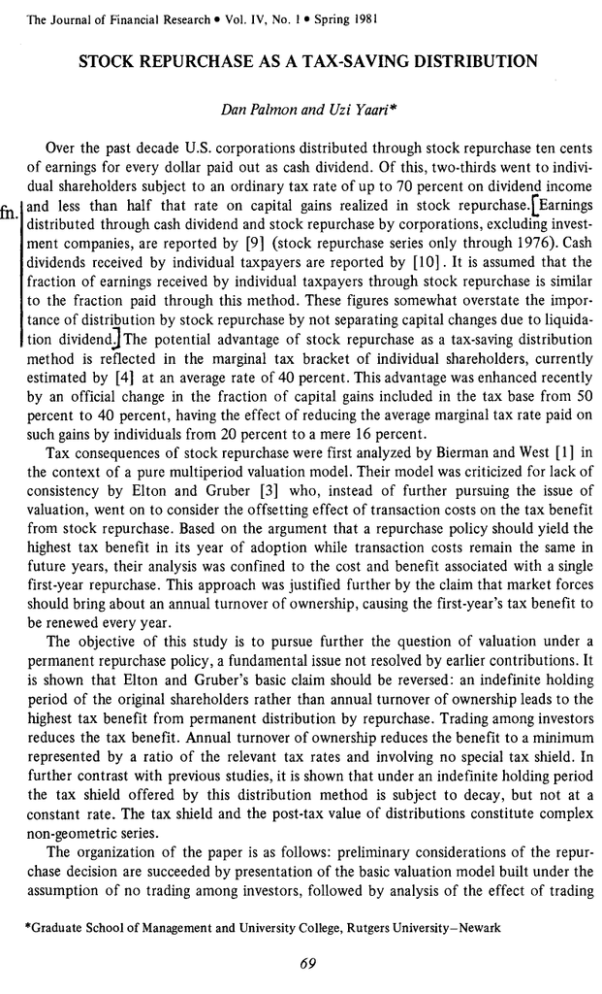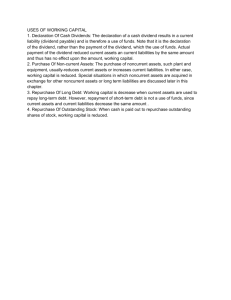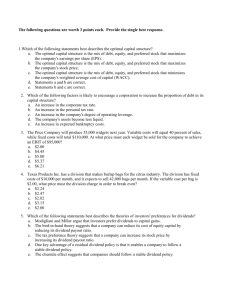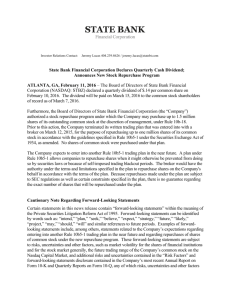STOCK REPURCHASE AS A TAX-SAVING DISTRIBUTION Uzi
advertisement

The Journal of Financial Research Vol. IV, No. 1 Spring 1981 STOCK REPURCHASE AS A TAX-SAVING DISTRIBUTION Dan Palmon and Uzi Yaari* Over the past decade U.S. corporations distributed through stock repurchase ten cents of earnings for every dollar paid out as cash dividend. Of this, two-thlrds went t o individual shareholders subject to an ordinary tax rate of up to 70 percent on dividend income and less than half that rate on capital gains realized in stock repurchase.[~arnings distributed through cash dividend and stock repurchase by corporations, excluding investment companies, are reported by [9] (stock repurchase series only through 1976). Cash dividends received by individual taxpayers are reported by [ l o ] . It is assumed that the fraction of earnings received by individual taxpayers through stock repurchase is similar to the fraction paid through this method. These figures somewhat overstate the importance of distribution by stock repurchase by not separating capital changes due to liquidation d i v i d e n d j ~ h epotential advantage of stock repurchase as a tax-saving distribution method is reflected in the marginal tax bracket of individual shareholders, currently estimated by [4] at an average rate of 40 percent. This advantage was enhanced recently by an official change in the fraction of capital gains included in the tax base from 50 percent to 40 percent, having the effect of reducing the average marginal tax rate paid on such gains by individuals from 20 percent to a mere 16 percent. Tax consequences of stock repurchase were first analyzed by Bierman and West [ I ] in the context of a pure multiperiod valuation model. Their model was criticized for lack of consistency by Elton and Gruber [3] who, instead of further pursuing the issue of valuation, went on to consider the offsetting effect of transaction costs on the tax benefit from stock repurchase. Based on the argument that a repurchase policy should yield the highest tax benefit in its year of adoption while transaction costs remain the same in future years, their analysis was confined to the cost and benefit associated with a single first-year repurchase. This approach was justified further by the claim that market forces should bring about an annual turnover of ownership, causing the first-year's tax benefit to be renewed every year. The objective of this study is to pursue further the question of valuation under a permanent repurchase policy, a fundamental issue not resolved by earlier contributions. It is shown that Elton and Gruber's basic claim should be reversed: an indefinite holding period of the original shareholders rather than annual turnover of ownership leads to the hlghest tax benefit from permanent distribution by repurchase. Trading among investors reduces the tax benefit. Annual turnover of ownership reduces the benefit to a minimum represented by a ratio of the relevant tax rates and involving no special tax shield. In further contrast with previous studies, it is shown that under an indefinite holding period the tax shield offered by this distribution method is subject to decay, but not at a constant rate. The tax shield and the post-tax value of distributions constitute complex non-geometric series. The organization of the paper is as follows: preliminary considerations of the repurchase decision are succeeded by presentation of the basic valuation model built under the assumption of no trading among investors, followed by analysis of the effect of trading *Graduate School of Management and University College, Rutgers University-Newark 70 f i e Journal of Financial Research on this model and demonstration of its consistency under the no-trading assumption. Finally, a summary and conclusions are presented. I. Preliminary Considerations Observe a carporation which has reached investmentlfinancial equilibrium expected to be maintained indefinitely, generating a constant expected stream of earnings. Let E denote the firm's annual post-corporate-tax earnings, tD a fixed marginal rate of dividend tax paid by the marginal shareholderiand r shareholders' fixed post-tax rate of return for the same risk class. The repurchase model developed below does not require the assumption of constant E and r, adopted soley for expositional convenience. A policy of full distribution by cash dividend would result in the familiar ex-dividend current value: v0 - E(1-to)- . (1) r Implicit in this formula are the following three assumptions: (1) The formula ignores transaction costs associated with the payment of dividends. Since periodic costs are essentially fixed per shareholder's account, on a per-share basis they decrease in the number of shares per holding (see Elton and Gruber [3] , Young and Marshall [12] , and Ellis and Young [2, pp. 43-4, 69-76]). If parameters affecting cost per holding are assumed to remain constant over time, annual dividend payment costs may be expressed as a fixed fraction of E and thus be assimilated in the present formula by redefining E. (2) In the presence of capital gains tax, this formula assumes that any future trading by the marginal shareholder will occur ex-dividend, at the original price. (3) The formula ignores opportunities for shareholder tax arbitrage. Simons [8, pp. 61-68] and Miller and Scholes [7] have shown that such opportunities may exist but offered no evidence that their exploitation is empirically significant. Suppose the firm plans to replace its cash dividend policy by one of permanent distribution through cash stock repurchase. In principle, the aggregate flow of earnings paid out in dividends can be distributed by repurchasing stock at the prevailing market price. Unlike dividends, an unprorated repurchase plan aimed at the general body of shareholders will allow the individual shareholder full control over the pattern of cash flow generated by his investment. There is a variety of institutional and private arrangements which fit the definition of a general, public, cash repurchase program. Whether in the form of a direct open-market purchase or an indirect cash tender offer, the program selected should minimize distribution costs imposed on shareholders. For a detailed discussion of relevant repurchase plans see Ellis and Young [2, pp. 109-141. Direct costs of distribution through stock repurchase are discussed by Elton and Gruber [3] and Marshall and Young [6]. By adjusting the number of shares redeemed to his current consumption and reinvestment plans, he will avoid unnecessary round-trip taxation at ?) and transaction costs entailed by distribution in excess of need under the strictly prorated cash dividend method. The economic significance of these costs is suggested by the 'The issue of tax clientele is avoided by assuming, as often done in theoretical discussions, the existence of a marginal shareholder for whom relevant characteristics are uniquely defined. Stock Repurchase As Tax-Saving Distribution 71 attempt t o circumvent them (but not the round-trip dividend tax!) through the use of highly advertised reinvestment plans. Furthermore, an unprorated stock repurchase will have the double-blessing of the IRS: of the entire amount distributed, only capital gains realized in redeemed shares will be subject to tax and this is at the favorable rate accorded such gains. Income created through stock redemption of a public corporation is taxed at the shareholder level as capital gains (Form 1040, Schedule D), rather than as income from partial liquidation of corporate equity (Schedule B). As noted by numerous authors (e.g., Weston and Brigham [11, p. 8086 public corporations engaging in other than prorated repurchase schemes are unlikely to be challenged under Sections 302 and 531, aimed mainly at closely-held companies. A case in point is the Tandy Corporation (NYSE) which distributes earnings exclusively through stock repurchase, with the declared objective of reducing shareholder tax exposure. In addition t o being uneconomic due to lesser shareholder flexibility, a pro-rata redemption plan is automatically treated as cash dividend under Section 302 of the Internal Revenue Code. 11. The Model The tax impact of stock repurchase as a permanent exclusive distribution method on the current value of the firm's equity is analyzed under the following simplifying assumptions: (a) The marginal investor redeems shares annually in quantities sufficient to duplicate his pre-tax annuity under cash dividend. This assumption has an attractive economic implication for shareholder consumption pattern and is consistent with the underlying non-growth model. As in the case of cash dividend, it also facilitates unambiguous share valuation by obviating unspecified tax effects of inter-distribution trading, called for in an environment of infrequent distribution. An analysis based on this assumption omits an important advantage of distribution by stock repurchase, namely, greater discretion by the individual shareholder over the pattern of cash flow derived from his holding. (b) The marginal investor does not trade in the open market or otherwise transfer ownership in his stock, except for annual redemption. This assumption, which tends to reduce the tax impact associated with this method, is subsequently relaxed. (c) Periodic distribution of stock dividend allows accurate compensation of the marginal investor through annual repurchase of a natural number of shares. The IRS ignores stock splits by calculating for tax purposes an adjusted price based on the number of shares held before the split. In the analysis below full divisibility is ensured by assuming that the marginal shareholder initially buys a sufficiently large number of shares to allow accurate periodic compensation. (d) Periodic transaction costs remain constant due to a stable volume of stock dividend distribution and stock repurchase, and a stable size distribution of ownership. Under this assumption transaction costs do not explicitly enter the model even though they can determine the optimal form of repurchase and method of distribution. As in the case of the dividend model, transaction costs which can be expressed as a fixed fraction of the underlying constant earnings can be readily incorporated in the repurchase model by redefining E. Figures cited by Elton and Gruber [3], Marshall and Young [6], and Ferris et al. [5] indicate that when charges of stock dividend payment are added to those imposed on the company and its shareholders under open-market repurchase, or to solici- 72 The Journal of Financial Research tation and brokerage fees under cash tender offer, the overall cost of distribution through repurchase may be substantial, and possibly higher than that of cash dividend. (e) No price premium is paid by the company on shares repurchased. This assumption, which implies repurchase at the prevailing market price, is consistent theoretically with an anticipated repurchase plan and empirically with a scenario of small regular purchases aimed at preserving shareholders' stable cash flow. Marshall and Young [6] found a substantial proportion of companies paying no premium in tender offers aimed at buying small shareholdings where a premium may be justified. Ferris et al. [5] report a preliminary finding of a positive but insignificant relationship between the relative size of the repurchase and the premium paid. Perhaps more indicative, their sample of 31 large tender offers averaging 25 percent of equity repurchased shows only a small premium averaging 1.1 percent of the price paid. Small amounts repurchased under a regular distribution program should be well withn the range of normal trading which, according to Ferris et al., averages 1.7 percent of the firm's equity per month. Finally, the high correlation found in their study between the soliciting fee and the premium further suggests that a premium is less likely to be paid under a regular, well-anticipated repurchase program. A. Formulating the effective tax rate Given that equity claims are priced based on their anticipated post-tax cash flows, assessment of the firm's current value must begin with formulation of the effective tax rate paid on distributions. Let Pi denote the price per share at the end of year i ( i 4 , 1,2,...) and tG the fixed marginal nominal tax rate of capital gains. Periodic payment of capital gains tax is an inseparable part of t h s method where earnings are distributed in the form of capital gains. Given that the ma~ginalholding is purchased at the end of year i=O for the unit price P o , the firm's current value would reflect the following tax payment in year i: (subject t o Pi > Pj for any i >j) where E/Pi is the number of shares redeemed at the going price Pi in order t o distribute earnings in the amount E, and tG(Pi-Po) the tax per share repurchased. The tax payment may be restated as: defining an effective marginal tax rate for year i: and a corresponding tax shield factor: Stock Repurchase As Tax-Saving Distribution 73 where: The tax shield stems from shareholders' privilege of reporting a portion of earnings received as repayment of principal. The benefit associated with t h s privilege is inversely related to Pi and, therefore, monotonically decreasing in time, vanishing under an infinite time horizon since lim Pi = =. It follows that the effective tax rate is monotonically f+ increasing in time, assymptotically approaching (from belowithe nominal rate tG with the advantage over cash dividend approaching a constant, tD-tG. The presence of a positive tax shield under a finite time horizon has an interesting policy implication. As noted by Bierman and West [ I ] , the tax loophole associated with this form of distribution would not be closed by raising the applicable tax rate to that of cash dividends. Closing the loophole would require taxing the entire repurchase proceeds as cash dividend or prohibiting stock redemption altogether, as under British law. The option of taxing the entire proceeds as cash dividend is impractical since it calls for discrimination among stock sales based on the identity of the buyer. - B. Calculating the sequence of tax payments The changing effective tax rate cannot be calculated from (2) which contains the unknown changing tax shield factor. The difficulty stems from the fact that (2) specifies the sequence of tax shelds as dependent upon the unknown infinite sequence of prices which, in turn, depends upon the sequence of tax shields. This difficulty is resolved in three steps: first, the tax shield is expressed as a function of current price change as opposed t o absolute price; second, the price change is expressed as a function of the preceeding year's tax sheld; and third, the sequences of price changes and tax shields are evaluated simultaneously in a recursive manner starting with the first year's price change. Step 1: Expressing Sj as a function of current price change Consider the rate of price appreciation (shareholder's pre-tax rate of return) in year i, defined by: 'i=- Pi- Pi-1 Pi-1 (ui > 0) such that: The sequence of 1 t uiover the years 1,2,...i can be used to rewrite (3) as: The Journal of Financial Research or, in terms of the shield in year i-1, as: Step 2: Epressing ui as a function o f Si-, The assumption of competitive market equilibrium sets the condition that the post-tax rate of return earned by the marginal shareholder in any year i be r, namely: yielding an expression for ui in terms of tF : ui = r 1 - ty Based on (4), ui can be expressed as a function of Si: or, noting (6), as a function of Si- yielding a single admissible solution for ui in terms of Si- : Step 3: Calculating the sequences /ui] and /Si] According to (9,Si- in (9) is a function of the sequence [ui] over years 1,2,...,i 1, from which it follows that ui is a function of [ui] over the same years. Calculation of ui, Stock Repurchase As Tax-Saving Distribution 75 and thus Si, for any desired i must begin by evaluating ui for i=l. Equation ( 5 ) indicates the relationship S , = l / ( l + u l )substituted for Si in (8) t o yield: and a solution representing a simplified version of (9): r- I t J ( I+r)2 - 4 r t ~ with u l as a function of known values of r and tc. Having evaluated u l , the sequences [ui] and [Si] may be calculated recursively in an increasing order of i: S 1 ,u2, S2 , U S ,..., by alternating between equations (6) and (9). Once evaluated, [Si] is substituted in ( 4 ) to produce the sought sequences of effective annual tax rates [tJ;]and tax payments [ E t f 1 . 2 C. Calculating the firm S current value Although the relationship lim t f = tc indicates that the sum of the infinite series of discounted tax payments conkzges, it is apparent from (6) and ( 9 ) that this series has no closed-form solution. Such a solution is not necessary, however, in order to obtain the current value : which may be approximated with the desired degree of accuracy by calculating maximum and minimum which converge upon this value for i+. A maximum current value is calculated under the assumption that the effective tax rate does not increase beyond some year N , remaining constant through infinity at the level t s : E N EtG r -1 ( vyau=--C --L 1 - 1 . (1+dN Et$ r A minimum current value is calculated under the alternative assumption that the effective tax rate jumps up at year N+1 to a level commensurate with a tax shield factor of zero, a level reached according to (4) and ( 5 ) only at infinity: The difference between the maximum and minimum values: The Journal of Financial Research 76 TABLE 1.-Tax Advantage Produced by the Shield: Current Value of a Dollar Earnings Perpetuity (E=$l)Distributed Through Stock Repurchase.' Capital gains tax rate Trading among investors none 10% annual none 20% annual none 35% annual Investor's discount rate 5% 10% 15% 25% $18.958 (1.053) 18.000 $9.467 (1.052 9.000 $6.304 (1.051) 6.000 $3.774 (1.048) 3.600 17.876 (1.117) 16.000 8.913 (1.114) 8.000 5.926 (1.111) 5.333 3.538 (1.106) 3.200 16.171 (1.244) 13.000 8.039 (1.237) 6.500 5.330 (1.230) 4.333 3.165 (1.217) 2.600 'Numbers in parentheses represent the "no trading" to "annual trading" ratio of current values. approaches zero as the values converge from above and below on the true value V O , under N+. Practically, however, a reasonably short time period (say, 25 years) is sufficient to reduce the difference to a negligible one. This technique was used to calculate numerical examples displayed in the table, representing current values of a dollar perpetuity (E=$l) under various rates of discount and capital gains tax subject t o the assumption of no trading among investors. For example, the combination of r=.10 and tG=.20 results in a current value of $8.91. Under the present tax law setting tG=.4tD, this value is 78 percent higher than the current value of $5.00 associated with cash dividend [eq. (I)] . The proportional advantage of stock repurchase may substantially increase with the shareholder's tax bracket and is essentially independent of the rate of discount. 111. Valuation with Trading Among Investors The tax impact implied by exclusive stock repurchase distribution has been evaluated thus far under the strong assumption that the marginal shareholder retains permanent ownership over his stock. Since any trading among investors would result in earlier payment of capital gains tax, this assumption tends to understate the tax impact associated with this method and overstate its advantage over cash dividend. The adverse effect of trading on the firm's current value may be verified by examining the other extremes of the spectrum of trading possibilities, assuming that the marginal shareholder sells the unredeemed portion of his holding at the end of every year. The tax consequences of t h s assumption are identical to those produced by taxing capital gains upon accrual. The resulting one-year holding period would imply the tax perpetuity EtG and the current value Vo =- E(l -tG) Stock Repurchase As Tax-Saving Distribution 77 indicating a reduced advantage vis-a-vis cash dividend (as long as tG < t o ) due to the elimination of the tax shield. This result, which most likely understates the real value of the tax shield and the relative tax saving of this method, is illustrated numerically in the table. Vertical comparison of current values resulting from "no trading" and "annual trading" indicates that the impact of the shield increases with the tax rate. Horizontal comparison shows that thls impact is virutally unaffected by the discount rate. N.Consistency Under the Assumption of No Trading The consistency of a no-trading valuation model requires that at no time over a finite horizon can a marginal outsider successfully bid for marginal shares by offering to pay a price in excess of the price asked by the marginal insider. (Consistency of the model requires, in addition, that the tax impact may not be further reduced by a delay in distribution. It can be shown that retention will actually increase the tax impact even if it does not induce trading among investors.) It is argued below that t h s condition is met in the present model, despite appearance to the contrary. In criticizing the no-trading model proposed by Bierman and West [ I ] , Elton and Gruber [3] claim that outsiders' competitive bid for a given pre-tax flow of income remains constant over time and would exceed the dirninshng post-tax value of the same income implied by the dirninishlng tax shleld in the absence of trading. This leads them to argue that outsiders may successfully bid for the stock as early as the end of the first year, negating the assumption of a perpetual holding period. In terms of equation (3), given the increasing price path described by the model, the insider's tax shield in any given year i is Polpi,which beyond the first year is clearly smaller than the outsider's l/Pi, since Po < Pi- for any i > 1. shield PiT h s criticism, which applies equally well to the present model, is invalid: it is the marginal insider's asked price rather than his bid price that should be compared to the outsider's bid price to determine the benefit from premature trading! The valuation model offered herein describes the time path of a bid price, representing the share value to an insider expecting to hold the stock forever. His asked price in a voluntary premature sale must be sufficiently higher at any given point in time to offset the increased tax impact resulting from a sale at that point. The demonstrated increase in the tax impact under full annual trading indicates, specifically, that the asked price at the end of the first year would be sufficiently high to more than offset the extra tax advantage sought by outsiders at that point in time. The logic behind this statement is simple: had the outsider's potential advantage exceeded the insider's tax disadvantage in a premature sale, the stock would be traded annually, This, however, is inconsistent with results presented herein showing a greater tax impact under annual trading than under an indefinite holding period. Using similar logic it can be shown that any trading over a finite horizon increases the tax impact, from which it follows that the insider's asked price path over a finite horizon exceeds the outsider's bid price such that no trading will take place. V. Summary and Conclusions The valuation model developed in this paper makes it possible to assess the tax impact of a stock repurchase policy and to compare it to that of cash dividend. The tax advan- 78 The Journal of Financial Research tage of stock repurchase is attributed to two sources-one constant in size, due to the favorable treatment of capital gains; and the other diminishing over time, due to the tax shield present in the sale of any capital asset. It has been shown that the extent of the latter advantage is at a maximum under the assumption of no trading among investors, is diminishing in the presence of such trading, and is eliminated under annual trading of all shares or taxation of gains on an accrual basis. Since the minimal tax advantage of stock repurchase vis-a-vis cash dividend is substantial, and this advantage is further augmented by savings in round-trip dividend tax and transaction costs, results presented here only help sharpen the question of why, in fact, corporations rely primarily on cash dividend. One possible explanation lies in observable factors not dealt with in this paper. For example, Elton and Gruber [3] show that stock market commission and fee structure is likely to favor cash dividend in stocks characterized by small holdings. Similarly, to the extent that stockholders prefer a frequent distribution of even amounts, a repurchase plan designed t o satisfy small holdings requires frequent stock splits at high ratios, the cost of which may be prohibitive. Lastly, small holdings may bear a substantial opportunity cost by losing the tax exemption accorded small amounts of dividend income. Another explanation for the dominance of cash dividend, relevant for stocks of large as well as small holdings, may be found in an unobservable factor omitted in the analysis: the potential reaction of the IRS and Congress. Systematic tax avoidance through stock repurchase, especially if exercised by a large number of corporations, is likely to be regarded as such and result in punitive and corrective measures. In Henry Simons' words [8, p. 681 : The way a law actually works is determined not merely by what it is but also and largely by what it is likely to become. Many obvious avoidance opportunities are not fully expolited simply because people don't expect them to last; and tax lawyers doubtless recognize that they will last longer if not overworked or exploited conspicuously. Besides, one can't afford to carry out elaborate, expensive avoidance arrangements when future legislation is highly uncertain and the law obviously unstable. REFERENCES 1.H. Bierman, Jr. and R. West. "The Acquisition of Common Stock by the Corporate Issuer," Journal of Finance, (December, 1966), 687-696. 2.C.D. Ellis and A.E. Young. The Repurchase of Common Stock. New York: The Ronald Press Co., 1971. 3.E. Elton and M. Gruber. "The Effect of Share Repurchase on the Value of the Firm," Journal of Finance, (March, 1968), 135-149. 4.M. Feldstein and D. Frisch. "Corporate Tax Integration: The Estimated Effects o n Capital Accumulation and Tax Distribution of Two Integration Proposals." National Truc Journal, (Mach, 1977), 37-52. 5.K.R. Ferris, A. Melnik, and A. Rappaport. "Facts Influencing the Pricing of Stock Repurchase Tenders," Quarterly Review of Economics and Business, (Spring, 1978), 31-39. 6.W.S. Marshall and A.E. Young. "A Mathematical Model for Re-acquisition of Small Shareholdings," Journal of Financial and Quantitative analysis, (December, 1968), 463-69. 7.M.H. Miller and M.S. Scholes. "Dividends and Taxes," Journal of Financial Economics, (December, 1978), 333-364. 8. H.C. Simons. Federal Tax Reform. Chicago: University of Chicago Press, 1950. Stock Repurchase As Tax-Saving Distribution 79 9.U.S. Board of Governors of the Federal Reserve System, Federal Reserve Bulletin. Washington, D.C. 10.U.S. Department of the Treasury, Internal Revenue Service, Statistics of Income, Individual Income Tax Returns. Washington, D.C. ll.J.F. Weston and E.F. Brigham. Managerial Finance. Hinsdale, Illinois: The Dryden Press, 1978. 12.A.E. Young and W.S. Marshall. "Controlling Shareholder Servicing Costs," Harvard Business Review, (January-February, 1971), 17-78.





